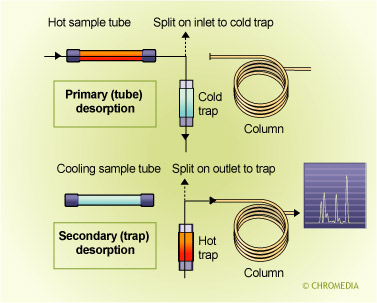Thermodesorption
- Page ID
- 61199

In the thermal desorption mode, a tube containing material from which compounds are to be desorbed is placed in the carrier gas flow line. This material may be an adsorbent such as Tenax-TA on which volatiles have been previously collected off line, or any sample in which the volatiles are required. Thus powdered solid sample such as rock, polymers, paper, etc. have been examined by this technique. The tube is electrically heated to a suitable temperature to volatilize the volatiles and the gas flow carries them to a cold trap where they are condensed The cold trap consists of a length of fused silica capillary tubing which may be coated with either a chemically bonded phase, or a layer of adsorbent such as aluminium oxide, and it is cooled in a suitable refrigerant. Other commercial systems use variations of the method for collecting the desorbed volatiles, including re-adsorption in a small trap near the start of the column. When the volatiles have been completely removed from the sample matrix they are quickly released from the cold trap by rapidly heating it via an electrical heating jacket. They consequently pass on to the column which then commences its programme. Thus the total volatiles are sampled by the column as a sharply focused zone.
Thermal desorption techniques are used widely for the analysis of trapped atmospheric volatiles and headspace samples, while purge and trap techniques are favored for aqueous samples.
When (solid) samples are heated rapidly above their decomposition temperature, we speak of pyrolysis injection. This technique is often used for the analysis of polymers.

